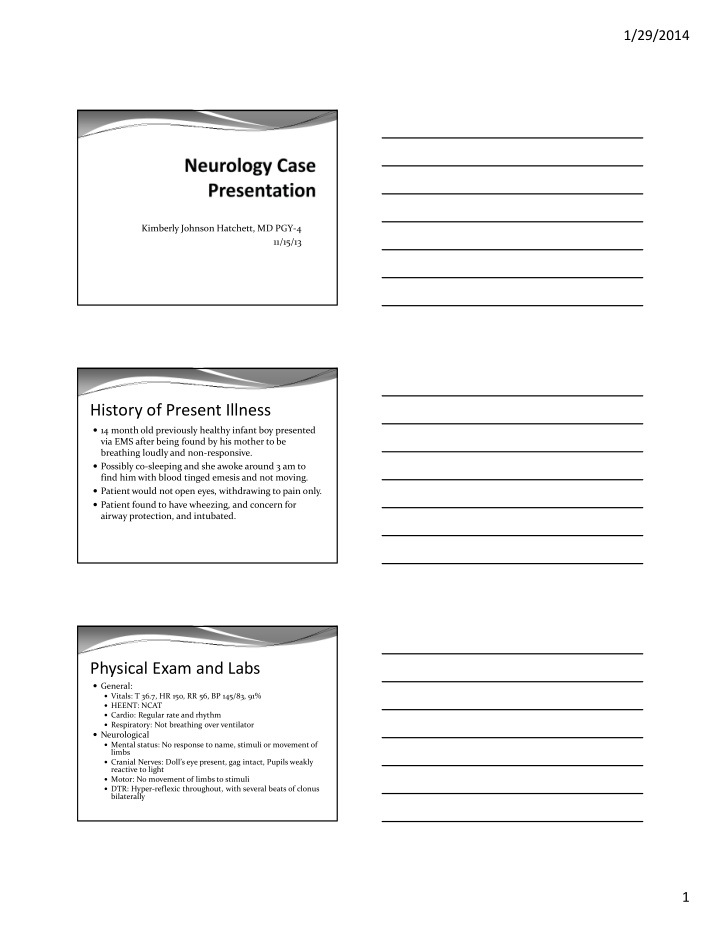



1/29/2014 Kimberly Johnson Hatchett, MD PGY-4 11/15/13 History of Present Illness � 14 month old previously healthy infant boy presented via EMS after being found by his mother to be breathing loudly and non-responsive. � Possibly co-sleeping and she awoke around 3 am to find him with blood tinged emesis and not moving. � Patient would not open eyes, withdrawing to pain only. � Patient found to have wheezing, and concern for airway protection, and intubated. Physical Exam and Labs � General: � Vitals: T 36.7, HR 150, RR 56, BP 145/83, 91% � HEENT: NCAT � Cardio: Regular rate and rhythm � Respiratory: Not breathing over ventilator � Neurological � Mental status: No response to name, stimuli or movement of limbs � Cranial Nerves: Doll’s eye present, gag intact, Pupils weakly reactive to light � Motor: No movement of limbs to stimuli � DTR: Hyper-reflexic throughout, with several beats of clonus bilaterally 1
1/29/2014 Physical Exam and Labs � Labs � CBC: WBC 39.5, Hgb 11.2, Plt 501, PT 22.8 � BMP: Na 134, K 5.8, Creat 0.66, Glu 445, Lactic Acid 10.4 � AST 2654, ALT 2150, Amylase 659 � CSF studies: Protein 255, Glucose 130, RBC 37, WBC 92 � (92% monocytic – macrophages containing pigment consistent with hemosiderin) � Toxicology screen: Venlafaxine and Norvenlafaxine MRI BRAIN on hospital day 1, 2
1/29/2014 MRI BRAIN on hospital day 1, MRI BRAIN on hospital day 1, 10/14/13 Differential � Infectious: Herpes, Varicella, Mycoplasma,West Nile, EBV � Toxic injestion � Post infectious cerebelitis with septic emboli (Rhinovirus/Enterovirus was positive in respirations) � Suffocation, Hypoxic Injury. 3
1/29/2014 Continued story � Interim Physical Exam � Initial EEG completed � After initial HSV PCR negative, and with OK from Infectious Disease started on High dose steroids for Cerebral Edema � Follow up MRI scan on hospital Day 5…. MRI BRAIN on hospital day 5, MRI BRAIN on hospital day 5, 4
1/29/2014 MRI BRAIN on hospital day 5, Story continued � Induced Hypothermia � Pentobarbital coma with patient in burst suppression � EVD placed to monitor intracranial pressure � Warmed on Hospital Day 8 � Stopped Pentobarbital � Electrographic/clinical seizures noted � Placed on additional Antiepileptic � Trileptal at 50 mg/kg/day, Phenobarbital 10 mg/kg/day, Keppra 87.5 mg/kg/day � Developed left sided chorea, started on Clorazepate 0.3125 mg/kg/day (1.875 mg bid) � Developed Rash � ACHSS or DRESS � Currently in ICU for treatment of skin lesion and systemic reaction MRI BRAIN on hospital day 8, 5
1/29/2014 MRI BRAIN on hospital day 8, Hypoxic Ischemic Encephalopathy � Clinical evidence of acute or sub-acute brain injury due to asphyxia � Systemic hypoxemia and/or reduced cerebral blood flow � Birth asphyxia = 23% of neonatal deaths world wide. � Mild versus Moderate versus Severe � Locations: Watershed, Basal Nuclei, can involve white matter and extend to the gray. 6
1/29/2014 7
1/29/2014 Take home points, conclusions � HIE, Hypoxic Ischemic Encephalopathy � MRI findings and functional outcome � Cooling and Outcomes, Not much difference? � How soon should repeat scan be done? � MRI scoring system gives tools to be able to predict future outcomes. 8
1/29/2014 References � Srinivasakumar P, Zempel J, Wallendorf M, Lawrence R, Inder T, Mathur A. Therapeutic hypothermia in neonatal hypoxic ischemic encephalopathy: electrographic seizures and magnetic resonance imaging evidence of injury. J Pediatr. Aug 2013;163(2):465-70. � Grow J, Barks JD. Pathogenesis of hypoxic-ischemic cerebral injury in the term infant: current concepts. Clin Perinatol. Dec 2002;29(4):585- 602, v. � Shankaran S, Laptook AR, Ehrenkranz RA, et al. Whole-body hypothermia for neonates with hypoxic-ischemic encephalopathy. N Engl J Med. 2005; 353:1574–84. [PubMed: 16221780] � Barkovich AJ, Hajnal BL, Vigneron D, et al. Prediction of neuromotor outcome in perinatal asphyxia: evaluation of MR scoring systems. AJNR Am J Neuroradiol. 1998; 19:143–9. [PubMed: 9432172] � Rutherford M, Ramenghi LA, Edwards AD, et al. Assessment of brain tissue injury after moderate hypothermia in neonates with hypoxic- ischaemic encephalopathy: a nested substudy of a randomised controlled trial. Lancet Neurol. 2010; 9:39–45. [PubMed: 19896902] Thank you � Questions????? 9
Recommend
More recommend